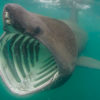Imagine coming to a nice, long stretch of sandy beach, fully intent on finding a spot to settle in. But when you do, there are already others there with the same idea. Why, there are thousands, millions — even billions — packed in. Virtually every square inch of sand is occupied, making it hard to even get a foothold! What would you do?
Well, if you are a beach-going human being, you might decide to try the mountains on this particular occasion. But if you are a beach-going bean clam, you likely have no choice but to just dig in however best you can, and hope for the best.
Fortunately, for people, this scenario never really comes about, (even though on some summer holiday weekends, it may seem like there are billions of other people on the beach!) But when it comes to certain species of California clams, this situation is no exaggeration.
So much so that in the late nineteenth century, canneries were established to tap into the fantastic numbers of bean clams. Granted, an individual bean clam, with a shell less than one inch long, won’t make much of a meal. But when they were found in such staggering concentrations of over 20,000 individuals per square meter of sand, commercial harvesting made perfect sense. Furthermore, soup, broth or chowder made from these tiny clams was big-time tasty and good.
Nowadays, however, bean clams are generally not gathered commercially. Legally, they could be, just as they can be by sportsfishermen, and they taste as good as ever. But there just aren’t all that many bean clams to be found anymore.
Aha! This would seem to be another classic example of overexploitation. True, that may have been a factor, but the main reason bean clams aren’t often to be found is simply because bean clams do that. Some years there are billions, then, all of a sudden, there will be a total dearth and not a single bean clam can be found anywhere. It is not really known what factors all come into play in this “feast or famine” cycle.
When bean clams are around, they are easy to identify. Their shells are smooth, with slight radiating lines. The outside of the shells is light colored, while the inside is purplish. But the easiest feature to look for is wedge-shaped of the shells, (which is why they are also at times called “wedge clams”).
There are two species of these small clams along the southern coast of California. Neither species gets much larger than one inch in length, and much less than that in width. The Little Bean Clam (D. gouldii) may occasionally make it as far north as Monterey, but its main range is from San Luis Obispo into Mexico. It is the species that is most often found in super-duper abundant numbers. The California Beach Clam (Donax californica), which ranges from Santa Barbara south, can also experience population explosions, but not typically to such a staggering degree.
Worldwide, there are dozens of other bean clams, mainly found in warmer waters. One of the most famous is the Coquina (D. variabilis) of Florida and other parts of the East Coast. This species has a long history of being found in super-abundance, so much so that layers upon layers of shell residue from generation after generation of clams have formed a usable grade of rock.
When alive, the Coquina is quite an active clam. If dislodged from the sand by a wave, it will surf up or down the beach, then quickly rebury itself. And always at about the same distance from the water line. Moreover, if the beach is jolted by a crashing breaker or a shovel, the Coquina often becomes a “jumping bean” clam as it momentarily pops itself out of the sand.
California’s bean clams are much more laid back in their habits. When they dig into the sand, they basically like to stay put. When enough of them are crammed together, they can thus give a normally smooth sandy beach a pebbly look.
When they are thus crowded, and there would seem to be no space for anything else to live — wouldn’t you know it? — “neighbors” move in to freeload! With only a tiny fraction of the little bean clam shells even exposed, the hydroid Clytia bakeri attaches itself and takes advantage of the opportunity to filter feed from the same nutrient rich waters the clams do.
Another “neighbor,” the moonsnail, however, isn’t even that “neighborly” but feeds on the clams themselves. Often evidence of these attacks can be seen in the neat holes found in bean clam shells which wash ashore. Then there are gulls and rays that feast on the abundance. All of these obviously know a good deal when they find it. And with hundreds, thousands, millions, even billions of bean clams all packed into the sand together to the point that it isn’t really possible for all the clams to survive anyway, what a deal for such predators and scavengers. Just be glad that you don’t have to compete for beach space with them!










